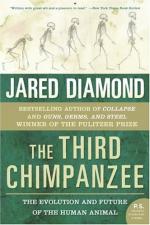
|
| Name: _________________________ | Period: ___________________ |
This test consists of 15 multiple choice questions and 5 short answer questions.
Multiple Choice Questions
1. The art produced was determined by professional artists to be what?
(a) Of high artistic value.
(b) Useless.
(c) Nonsense.
(d) Low art.
2. To qualify an object as art, the author suggests that it must fulfill how many qualities?
(a) Three.
(b) One.
(c) Four.
(d) Two.
3. What is a fundamental aspect of humanity and in general is easy to determine even by non-experts?
(a) Country of origin.
(b) Intelligence.
(c) Religion.
(d) Race.
4. What have a few captive gorillas and chimpanzees been taught to do?
(a) Read.
(b) Speak a human language.
(c) Use various non-vocal systems to communicate with sign or symbol languages.
(d) Sing.
5. How does the author believe that humans and chimps should properly be considered to be?
(a) One species within a single genus.
(b) Two species in two genera.
(c) Two species within a single genus.
(d) One species in two genera.
6. Where is there a disparity regarding adulterous relationships?
(a) Between the guilt felt by men and women engaging in these types of relationships.
(b) Between the religious consequences for men and women engaging in adulterous relationships.
(c) Between the legal consequences for men and women engaging in adulterous relationships.
(d) Between the benefits for men and women engaging in these types of relationships.
7. Several scientifically rigorous genetic investigations of large populations conclusively demonstrate that roughly ______ percent of human children are not the genetic children of the male parent whom assumes genetic relatedness.
(a) 25.
(b) 10.
(c) 20.
(d) 5.
8. Is agriculture the golden solution for human survival?
(a) No.
(b) In some cultures.
(c) Only in the United States.
(d) Yes.
9. When do chimps, humans, and gorillas break off from the remaining higher primates?
(a) C. 10 millions of years ago.
(b) C. 15 millions of years ago.
(c) C. 20 millions of years ago.
(d) C. 5 millions of years ago.
10. What does research show about those who are of one race and are raised by members of another race?
(a) They are attracted to those of either race.
(b) They are not attracted to anyone of either race.
(c) They are attracted to the race in which they were raised.
(d) They are attracted to those of their own race.
11. How selective are humans across an array of traits?
(a) Not at all.
(b) Slightly.
(c) Minimally.
(d) Highly.
12. This view on sexual strategies is completely consistent with what?
(a) The standard accepted theory of evolution by means of sexual selection.
(b) The standard accepted theory of evolution by means of natural selection.
(c) The standard accepted view of only a few cultures.
(d) The standard view of most cultures.
13. Ideals of beauty vary ___________________ from culture to culture.
(a) Somewhat.
(b) Not at all.
(c) Slightly.
(d) Enormously.
14. What physical traits tend to be significant for an individual's attraction to someone else?
(a) Traits that contrast with one's own.
(b) Traits that closely approximate their own.
(c) Traits that are different from one's own.
(d) Traits that are not dominant in one's own.
15. What does the author say about primates with small testes?
(a) They mate infrequently.
(b) They mate frequently.
(c) They are more aggressive.
(d) They are more complaisant.
Short Answer Questions
1. What does the fact that the many vocalizations among groups of the same species vary significantly from group to group indicate?
2. Of what have several researchers focused on the vocalizations?
3. The artistic endeavors of what animals are presented and considered?
4. Do all animals that show artistic tendencies satisfy each criterion?
5. What is the size ratio between a male and female in monogamous species?
|
This section contains 615 words (approx. 3 pages at 300 words per page) |

|




